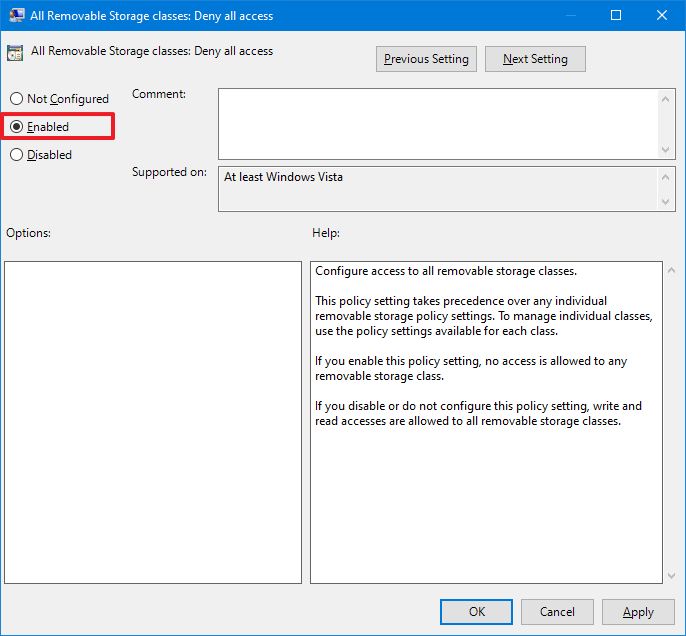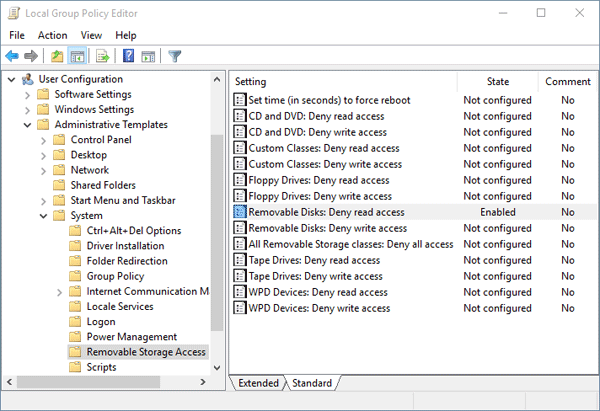
- DISABLE MASS STORAGE DEVICE WINDOWS 10 HOW TO
- DISABLE MASS STORAGE DEVICE WINDOWS 10 INSTALL
- DISABLE MASS STORAGE DEVICE WINDOWS 10 SERIAL
Intune is supposed to change this back if the policy is removed but we're having some weird issue in our environment. On Windows 10, if a USB or another supported port is available on the computer, users can connect removable storage devices (such as USB flash drives, external hard drives, and other types of mass.
DISABLE MASS STORAGE DEVICE WINDOWS 10 HOW TO
HKLM\SOFTWARE\Microsoft\PolicyManager\current\device\System 322756 How to back up and restore the registry in Windows If a USB storage device is already installed on the computer, set the Start value in the following registry key to 4: HKEYLOCALMACHINESYSTEMCurrentControlSetServicesUsbStor When you do this, the USB storage device does not work when the user connects the device to the computer. UPDATE: For anyone who happens to need this later, the policy changes the following registry key: Also, is there any way to turn off USB storage blocking without retiring the device? This is for Windows 10, specifically. As with disabling USB storage drivers, create a new Group Policy, this time called Enable Mass Storage Device. It is not enough to simply take the PC out of the Disable Group Policy as the device drivers will remain disabled. Is this actually the case? This seems excessive. To re-enable the mass storage devices on a Windows XP system, you need to create a second Group policy. Additionally, I may have to retire the machine to undo the policy and re-enroll. Some initial research seems to suggest that Intune keeps the more "secure" policy in place, even if there's a change. The exclusions never worked, so we made it only All Users (thinking the machine policy was canceling out the exceptions). Originally, we had the policy assigned to All Users & All Devices and we excluded an on-prem AD Security Group of users (IT Admins who needed to restore user data at slow network sites). Under "Device Restrictions", I selected "Removable Storage" -> Block. Now if you’d rather completely disable USB storage devices from being detected in Windows, without disabling keyboard, mouse, printer, and other USB devices, this post will help you achieve that. Double click on it to open a tab for changing its settings.I created a Device Configuration - Profile to block USB Removable Storage. Earlier I had showed you ways to make USB storage devices read-only to protect others from copying your data. Step 4: On the right-side panel, locate All Removable Storage classes: Deny all access. Step 3: Here go to the Computer Configuration> Administrative Templates> System> Removable Storage Access. Step 2: This will open the Local Group Policy Editor for your system. Step 1: Click on the desktop, and press Windows key + R. Step 4: Right-click on the USB port and disable/enable the port. Step 3: You will get the list of USB ports. Step 1: Go to Start Menu, type “devmgmt.msc” in the Search box to open Device Manager If you wish to use your USB device on your work computer or stop anyone from using your computer to transfer data, then follow these steps to disable USB drivers: You can disable/enable or disable the USB ports through Device Manager.
DISABLE MASS STORAGE DEVICE WINDOWS 10 INSTALL
If not found, Windows will prompt you to install the driver. Note: If you wish to install the USB driver in future, plug-in your USB drive and Windows will check for drivers. Step 4: Right Click on the USB port and uninstall the driver to disable the port. Step 3: You will get the list of USB ports


DISABLE MASS STORAGE DEVICE WINDOWS 10 SERIAL
Step 2: Click on the Universal Serial Bus Controllers.


 0 kommentar(er)
0 kommentar(er)
